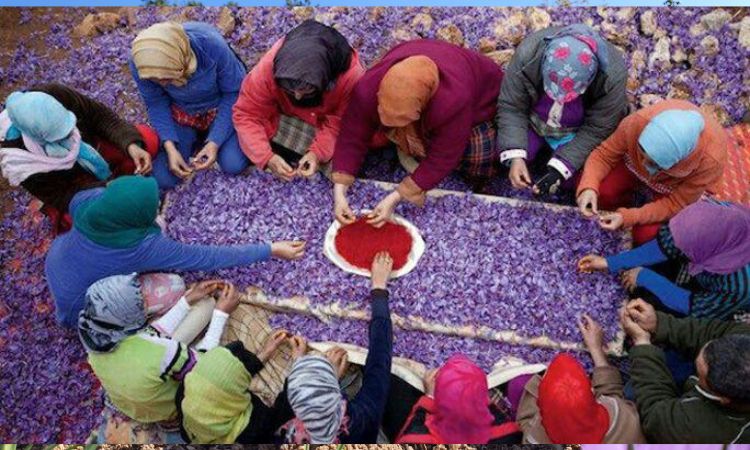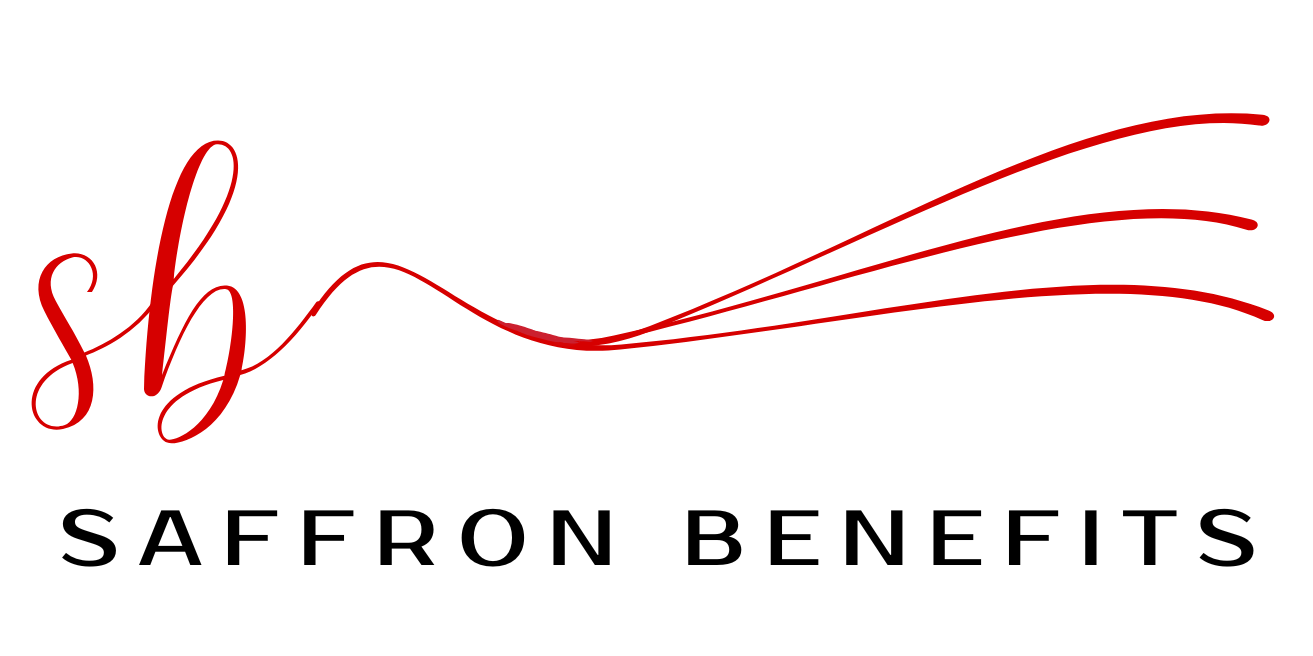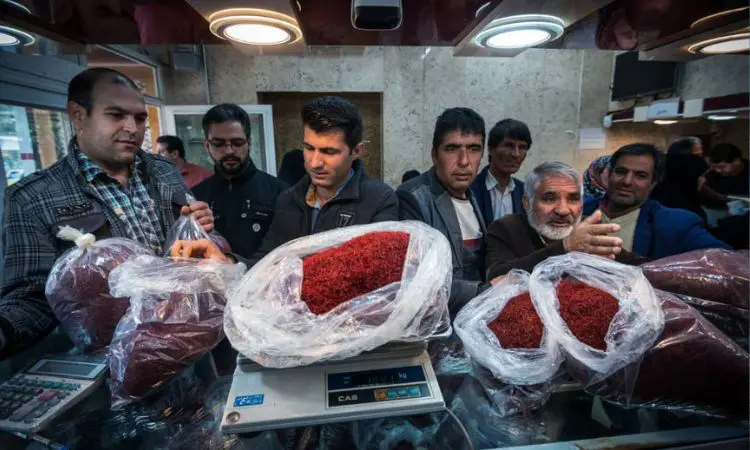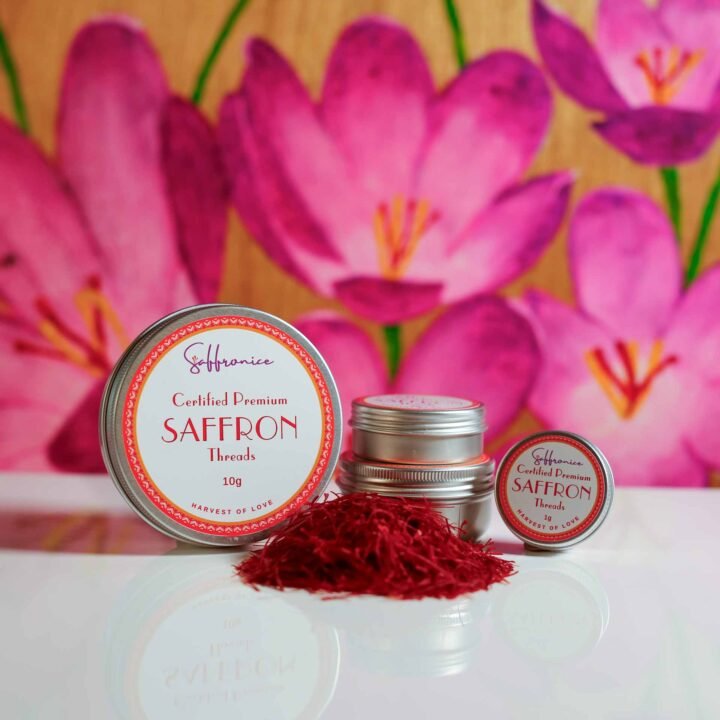📌 Quick Answer: Iran leads global saffron production with over 90% market share, followed by Spain, Kashmir (India), Afghanistan, Greece, Italy, and Morocco. These countries benefit from ideal climate conditions, traditional cultivation methods, and growing international demand for premium saffron.
Saffron, often called “red gold,” represents one of the world’s most valuable spices by weight. This highly prized ingredient has captivated global markets for centuries with its unique aroma, delicate flavor, and vibrant crimson color. The global saffron industry generates over $1.5 billion annually, with production concentrated in specific regions where saffron cultivation thrives under precise environmental conditions.
Chef’s Professional Tip: Having worked with saffron from different regions, I’ve observed that each producing country offers distinct flavor profiles – Iranian saffron provides intense color and aroma, while Spanish saffron delivers more subtle, sweet notes perfect for paella.
Key Takeaways: Global Saffron Production Landscape
- Iran dominates with 92% of world production (300+ metric tons annually)
- Spain leads European production through La Mancha region’s premium saffron
- Kashmir produces ultra-premium grade saffron with unique characteristics
- Emerging markets like Afghanistan and Morocco are rapidly expanding
- Quality standards and certifications drive international market access
- Sustainable practices are becoming crucial for long-term industry viability

Understanding Global Saffron Market Dynamics
The international saffron market operates as a complex ecosystem where geography, climate, and traditional knowledge converge. Current market valuation exceeds $1.5 billion, with projected annual growth of 7% driven by increasing culinary applications and expanding pharmaceutical uses.
Current Market Trends and Growth Drivers
Premium saffron demand continues rising globally due to several factors:
Culinary Renaissance: Professional chefs and home cooks increasingly seek authentic, high-quality ingredients. Saffron’s unique ability to enhance both flavor and visual appeal makes it indispensable in luxury cuisine.
Health and Wellness Focus: Growing awareness of saffron’s potential health benefits drives market expansion beyond traditional culinary applications.
Geographic Expansion: New markets in Asia, North America, and Australia are discovering saffron’s versatility, creating fresh demand streams.
Quality Standards Shaping International Trade
International quality standards play a crucial role in market dynamics. The ISO 3632 standard defines saffron grades based on:
- Crocin content (coloring strength): Minimum 200 for Grade I
- Picrocrocin levels (flavor intensity): Minimum 70 for premium grades
- Safranal concentration (aroma potency): Minimum 20 for top quality
- Moisture content: Maximum 12% for proper preservation
Food Scientist’s Note: These chemical markers directly correlate with saffron’s sensory qualities. Higher crocin levels produce deeper color, while balanced picrocrocin and safranal create the complex flavor profile that makes saffron irreplaceable.
Countries achieving consistent compliance with these standards command premium prices and secure long-term trading partnerships.
Iran: The Undisputed Global Saffron Leader
Iran maintains absolute dominance in global saffron production, contributing over 90% of the world’s supply. The country’s northeastern provinces, particularly Khorasan Razavi, South Khorasan, and Kerman, provide ideal conditions for saffron cultivation.
Production Scale and Regional Concentration
Iran produces approximately 350-400 metric tons of saffron annually, with the city of Torbat-e Heydarieh serving as the industry’s epicenter. This massive scale results from:
Optimal Climate Conditions: Iran’s saffron regions experience cold winters (-15°C), mild springs, and hot, dry summers – perfect for crocus bulb development and flower production.
Generational Expertise: Farmers in Iranian saffron regions have refined cultivation techniques over centuries, passing down knowledge about optimal planting depths, irrigation timing, and harvesting methods.
Government Support: Iranian authorities provide research funding, quality certification programs, and export facilitation services to maintain the country’s market position.
Quality Characteristics of Iranian Saffron
Iranian saffron, particularly from the Khorasan region, exhibits distinctive qualities that set global standards:
- Deep red color with minimal yellow or white parts
- Intense, complex aroma combining honey, hay, and metallic notes
- Strong flavor profile balancing sweetness with subtle bitterness
- Long, thick threads indicate careful harvesting and processing
The country’s premium saffron varieties often exceed international quality standards, making Iranian saffron the benchmark against which others are measured.
Spain’s Historic Saffron Production Heritage
Spain represents Europe’s largest saffron producer and holds significant cultural importance in saffron’s global story. The La Mancha region of central Spain has cultivated saffron for over 900 years, developing unique varieties and processing methods.
La Mancha: Europe’s Saffron Capital
The Castilla-La Mancha region produces approximately 1.5-2 tons of saffron annually, representing nearly all of Spain’s production. This region’s success stems from:
Protected Designation of Origin (PDO): Spanish saffron from La Mancha enjoys PDO status, guaranteeing authenticity and quality standards that protect both producers and consumers.
Traditional Cultivation Methods: Spanish farmers employ time-honored techniques, including hand-planting bulbs in September, careful flower harvesting at dawn, and immediate stigma separation to preserve quality.
Unique Terroir: La Mancha’s plateau climate, with its extreme temperature variations and well-draining soils, produces saffron with distinctive sweet, honeyed notes.
Market Position and Economic Impact
Despite lower production volumes compared to Iran, Spanish saffron commands premium prices due to its exceptional quality and European Union quality certifications. Many discerning consumers seeking authentic saffron specifically request Spanish varieties for their consistent quality and unique flavor profile.
Spanish saffron typically costs 15-25% more than comparable Iranian grades, reflecting both quality premiums and higher production costs in Europe.
Kashmir’s Ultra-Premium Saffron Industry
Kashmir produces what many consider the world’s finest saffron, though in relatively small quantities. The region’s unique geography and climate create conditions that produce saffron with unmatched aromatic intensity and color depth.
Geographical Advantages and Cultivation Methods
Kashmir’s saffron cultivation centers are in the Pampore region, situated at 1,600 meters in the Kashmir Valley. This location provides:
Himalayan Climate Benefits: Cold winters with snow cover protect bulbs, while moderate summers allow optimal flower development without excessive heat stress.
Alluvial Soil Composition: Rich, well-draining soils derived from Himalayan minerals provide ideal nutrition for saffron bulbs.
Natural Water Sources: Pristine mountain water ensures pure irrigation without chemical contamination.
Quality Characteristics and Market Recognition
Kashmiri saffron exhibits unique properties that distinguish it from other origins:
- Longest threads globally: Often exceeding 25mm in length
- Deepest red coloration: Higher crocin content than most international varieties
- Most intense aroma: Complex fragrance combining floral and earthy notes
- Zero artificial additives: Traditional processing methods avoid any chemical treatments
However, proper grading and authentication remain crucial, as Kashmir’s reputation sometimes attracts counterfeit products attempting to capitalize on its premium status.
Afghanistan’s Rapidly Growing Saffron Sector
Afghanistan has emerged as a significant player in global saffron markets, with production increasing dramatically over the past decade. The country now ranks among the top five global producers, with particularly strong growth in Herat and Balkh provinces.
Production Growth and Regional Development
Afghanistan’s saffron sector demonstrates remarkable expansion:
Production Volume: From virtually zero in 2010 to over 20 metric tons annually by 2024.
Geographic Expansion: Initially concentrated in Herat province, now spreading to Balkh, Ghor, and Badakhshan provinces.
Quality Improvements: Sustainable farming practices and international technical assistance have elevated Afghan saffron quality standards
Economic and Social Impact
Saffron cultivation provides crucial economic opportunities in rural Afghanistan:
Alternative Crop Development: Saffron offers farmers profitable alternatives to other agricultural options, supporting rural economic development.
Women’s Employment: Saffron harvesting and processing create significant employment opportunities for rural women, contributing to household incomes and community development.
Export Revenue: Afghanistan’s saffron exports generate valuable foreign currency earnings while building international trade relationships.
Mediterranean Saffron Belt: Greece and Italy
Greece and Italy represent important European saffron producers, each contributing unique varieties and maintaining centuries-old cultivation traditions.
Greek Saffron Production
Greece’s saffron industry centers in the Kozani region of northern Greece, producing approximately 6-8 tons annually. Greek saffron characteristics include:
Unique Processing Methods: Greek producers employ specific drying techniques that preserve delicate aromatic compounds while achieving optimal moisture levels.
Cooperative Organization: Most Greek saffron farmers participate in cooperatives that ensure quality standards, provide technical support, and facilitate international marketing.
EU Quality Certification: Greek saffron benefits from European Union quality programs that guarantee authenticity and sustainable production methods.
Italy’s Artisanal Saffron Industry
Italian saffron production, though smaller in scale, maintains significant cultural and economic importance in regions like Abruzzo, Sardinia, and Tuscany. Italian cultivation methods emphasize artisanal quality over quantity:
Regional Specialization: Different Italian regions produce distinct saffron varieties adapted to local conditions and traditional uses.
Agritourism Integration: Many Italian saffron farms integrate production with tourism, offering visitors experiences in harvesting and processing this precious spice.
Culinary Partnerships: Italian saffron producers often work directly with renowned restaurants and specialty food companies, ensuring premium market positioning.
Morocco’s Emerging Saffron Industry
Morocco represents one of the most promising emerging markets in global saffron production. The country’s High Atlas Mountain regions provide excellent conditions for saffron cultivation, while government initiatives support sector development.
Production Development and Growth Potential
Morocco’s saffron industry shows an impressive growth trajectory:
Geographic Expansion: Production initially concentrated near Taliouine now extends across multiple High Atlas regions.
Quality Improvement: Moroccan producers implement international best practices for harvesting and storage to meet export standards.
Market Access: Morocco actively develops export relationships with European and North American markets
Unique Characteristics of Moroccan Saffron
Moroccan saffron exhibits distinctive qualities reflecting the country’s terroir:
- Bright color intensity from high-altitude growing conditions
- Complex flavor profile combining traditional characteristics with unique regional notes
- Competitive pricing due to lower production costs and government support programs
- Organic certification has potential, as many farms employ traditional, chemical-free methods

Sustainable Practices Shaping Future Production
Environmental sustainability increasingly influences saffron production decisions globally. Leading producers implement practices that protect long-term industry viability while maintaining quality standards.
Water Conservation and Climate Adaptation
Saffron’s drought tolerance makes it suitable for regions experiencing water scarcity, but sustainable farming practices optimize resource use:
Precision Irrigation: Modern drip irrigation systems reduce water consumption while ensuring optimal soil moisture for bulb development.
Climate-Adapted Varieties: Research programs develop saffron varieties that maintain quality while tolerating changing climate conditions.
Soil Health Management: Organic matter enhancement and natural pest management protect soil ecosystems while supporting productive cultivation.
Economic Sustainability and Fair Trade
Sustainable saffron production also addresses social and economic factors:
Fair Pricing: Direct trade relationships ensure farmers receive fair compensation for their labor-intensive work.
Community Development: Saffron cooperatives provide technical training, quality certification, and market access support for small-scale farmers.
Cultural Preservation: Sustainable practices help maintain traditional knowledge and cultivation methods that define regional saffron characteristics.
Food Scientist’s Note: Sustainability in saffron production isn’t just environmental – it’s about maintaining the genetic diversity, traditional knowledge, and economic systems that make each region’s saffron unique and valuable.
Future Outlook for Global Saffron Production
The global saffron industry faces both opportunities and challenges as demand continues to grow. Success factors include quality consistency, sustainable practices, and market diversification.
Emerging Trends and Opportunities
Technology Integration: GPS-guided planting, weather monitoring systems, and blockchain traceability enhance production efficiency and product authentication.
Market Diversification: Beyond traditional culinary uses, saffron applications expand into pharmaceuticals, cosmetics, and functional foods, creating new revenue streams.
Value-Added Processing: Producers increasingly offer saffron extracts, powders, and specialty blends that command premium prices while extending shelf life.
Industry Challenges and Solutions
Authentication and Quality Control: Growing demand increases risks of adulteration, making reliable quality testing and brand authentication crucial for maintaining consumer trust.
Climate Change Adaptation: Shifting weather patterns require adaptive cultivation strategies and potentially new growing regions.
Labor Availability: Saffron’s hand-harvesting requirements create ongoing labor challenges that some regions address through mechanization research and seasonal worker programs.
Key Takeaways for Consumers and Industry
Understanding global saffron production helps consumers make informed purchasing decisions while supporting sustainable industry practices:
🔑 Key Points to Remember:
- Origin matters: Each producing region offers unique characteristics worth exploring
- Quality standards: Look for ISO certification and clear origin labeling
- Price reflects value: Authentic, high-quality saffron commands premium prices for good reason
- Sustainability support: Choose producers committed to environmental and social responsibility
- Traditional knowledge: Appreciate the centuries of expertise behind each saffron thread
The global saffron industry continues evolving, balancing traditional cultivation wisdom with modern sustainability practices. For consumers seeking to explore this remarkable spice’s full potential, understanding its health benefits, proper usage methods, and quality indicators ensures the best possible experience with this treasured “red gold.”
Whether you’re a professional chef, home cooking enthusiast, or simply curious about this extraordinary spice, the diversity and quality offered by the world’s leading saffron producers provide endless opportunities to discover new flavors, aromas, and culinary possibilities that have enchanted cultures for millennia.
Frequently Asked Questions
Which country produces the most saffron in the world? Iran is by far the world’s largest saffron producer, accounting for over 90% of global production with approximately 350-400 metric tons annually. The country’s Khorasan region provides ideal climate conditions and centuries of cultivation expertise.
What makes Spanish saffron different from Iranian saffron? Spanish saffron from La Mancha offers sweeter, more delicate flavors compared to Iranian saffron’s intense, complex profile. Spanish saffron also benefits from Protected Designation of Origin status and typically commands higher prices due to European quality certifications.
Why is Kashmir saffron considered the best quality? Kashmiri saffron features the longest threads globally, deepest red coloration, and most intense aroma due to the region’s unique Himalayan climate and mineral-rich soils. However, production volumes remain relatively small compared to major producers.
How do emerging producers like Afghanistan and Morocco compete with established markets? Emerging producers focus on competitive pricing, quality improvements through international technical assistance, and sustainable farming practices. They often target specific market niches or offer unique regional characteristics that differentiate their products.
What role do quality standards play in the global saffron market? International quality standards (particularly ISO 3632) ensure consistent product quality and enable fair price comparisons across different origins. These standards measure key components like crocin (color), picrocrocin (flavor), and safranal (aroma) that determine saffron’s culinary value.
Are sustainable practices important in saffron production? Yes, sustainability is increasingly crucial for long-term industry viability. This includes water conservation, soil health management, fair trade practices, and preserving traditional cultivation knowledge. Many consumers now specifically seek sustainably produced saffron.



